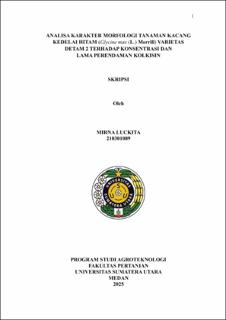| dc.description.abstract | Soybeans (Glycine max (L.) Merrill) are an important global legume crop that
grows in tropical, subtropical, and temperate climates. Soybeans are referred to
as the “protein hope” of the future because of their high nutritional value,
containing approximately 42–45% protein. In addition to being a raw material for
soy sauce production, black soybeans also play a role in the tempeh industry,
which is a traditional Indonesian food product. This study was conducted on land
at Gang Susuk VIII no. 3, Padang Bulan, Selayang 1, Medan City, North Sumatra,
at an altitude of ± 32 meters above sea level. This study aims to examine the
morphological characteristics of black soybean variety Detam 2, such as
increasing production, the number of pods, and pod weight per plant using
colchicine concentration and immersion treatments. This study was conducted
from January to May 2025. The research method used was a two-factor
Randomized Block Design (RAK) with 4 replications. The first factor was
Colchicine (C) for concentration levels, consisting of Control, 0.01%, 0.02%, and
0.03%. The second factor was Time (T) for the duration of immersion, which was
6 hours, 12 hours, and 18 hours. The results showed that colchicine concentration
did not have a significant effect on all observation parameters. The duration of
colchicine immersion had a significant effect on the number of leaves at 61 HST
and the number of pods per plant. The interaction between colchicine
concentration and immersion duration had a significant effect on the weight of
100 seeds but did not significantly affect other parameters. | en_US |


